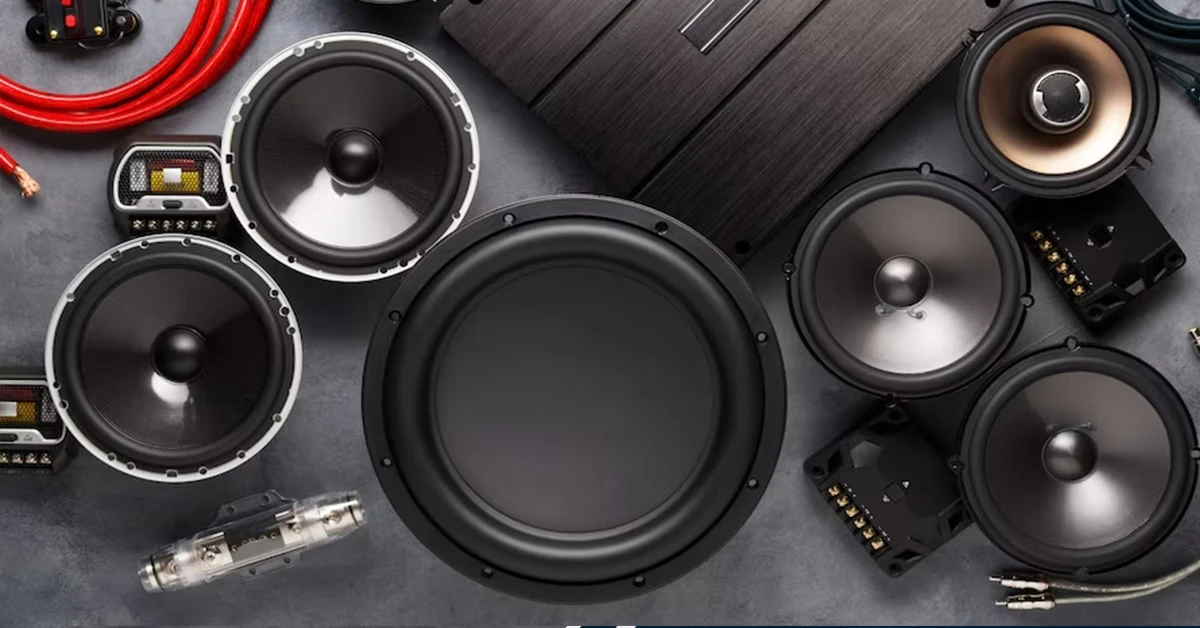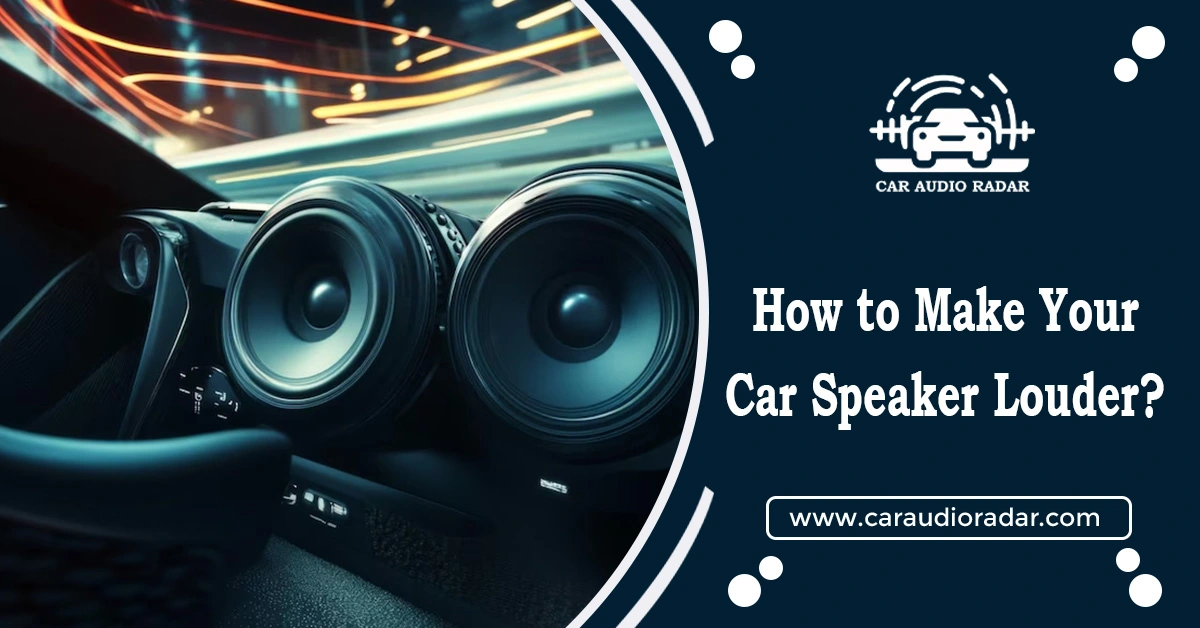
Jump to
What's Differences between 2-way, 3-way, and 4-way car speakers

Car speakers come in different configurations, such as 2-way, 3-way, and 4-way systems. The numbers refer to how many distinct audio components each speaker comprises. In a 2-way setup, a woofer and a tweeter work together for essential sound reproduction.
Moving to 3-way, an additional component like a mid-range speaker is added, enhancing the audio spectrum. With 4-way speakers, you get an extra feature, often a super tweeter, to deliver even more detailed high-frequency sounds.
Essentially, the more ways a speaker has, the more specialized components it employs, contributing to a richer and more nuanced audio experience in your car. In this article, you’ll learn about the differences between 2-way, 3-way, and 4-way car speakers. Also, we’ll tell you which speaker is best for your car.
Basic of Car Speakers System
Before delving into which car speaker is best for you, know how the speaker system works. Speakers in your car change the electric signals from your music system into mechanical energy. This energy makes the speaker’s parts vibrate, creating the sound we hear when playing music in your car.
Humans can hear sounds between 20 and 20,000 Hz, but the exciting part is that some speakers can handle a broader range of frequencies than others. When we say n-way speakers, the “n” means the number of components and “way” means components. Components are those vibrating parts of the speaker that make the sound. So, a 2-way speaker has two components, a 3-way has three components, and a 4-way has four components.
Every components can handle a different frequency range. Remember, the number of speaker components doesn’t decide how incredible an audio system. All of the above discussion doesn’t mean that knowing the differences between 2-way, 3-way, and 4-way car speakers isn’t essential.
Categories of Car Speakers
There are two main categories of speakers:
1. Component speakers
In component speakers, the woofer and tweeter are separate. This makes it simple for you to fit them in your car body.
2. Full-range speakers
In Full-range speakers, the woofer and tweeter are intact. This makes them easier to install and cheaper than the component speakers.
Speaker system Components
In this section, we’ll talk about the components that are used in speaker systems.
Woofer
The woofer is the most significant part of the speaker, with a diameter of up to 15 inches. It uses a lot of power because its main job is to create strong sound vibrations. A woofer is a speaker part that deals with low sound notes, usually between 20 to 200 Hertz if the speaker has midrange drivers. Without midrange, it handles sounds from 20 Hertz to about 1,000 Hertz.
Tweeter
The tweeter is the tiniest part of the speaker. It makes high-pitched sounds and is a few inches in size. The tweeter makes music energized by making it clear and bright. It handles the high notes and works at the end of the audio spectrum. This speaker part handles the high-pitched sounds, usually between 2 – 20 kHz.
Range
Also known as mid-range speakers. These are smaller in size than the woofers and also look the same. Its diameter is, at most, 8 inches. Sound frequencies that range produced are between low and high notes. Low notes are produced by the woofer, and high produced by the tweeter. These drivers handle the middle frequencies in the sound. They respond to frequencies between 200 Hertz to 5,000 Hertz.
2-Way Car Speakers
2-way speakers, also known as coaxial speakers, are the most common car speakers. These are cheap, and if you want to upgrade music quality in your car immediately, they are best for you.
2-way speakers, as the name implies, have two different sets of frequencies. A 2-way speaker has two components; each component covers a diverse range of frequencies. A woofer and a tweeter are used in 2-way speakers. Woofer produced low-frequency sounds and tweeter is used to produced high frequency sounds.
Summarized 2-Way Car Speakers
- They are not only cheap, but their installation process is also easy.
- A woofer and a tweeter are used in it to control low and high frequencies.
- These are the most common types used in-car audio systems.
Pros of 2-Way Speakers
- A two-way speaker setup needs a small box, making it compact.
- It has both a woofer and a tweeter for high and low sounds.
- It’s a budget-friendly choice.
- Great for improving music and reducing outside noises.
- Easy to set up and uses less power.
Cons of 2-Way Speakers
- 2-way speakers may lack mid-range sound due to the absence of a mid-range component.
- They might not play music as loudly as other types and additional bass output may require an extra subwoofer.
3-Way Car Speakers
3-way speakers, also known as tri-axial speakers, are the most common car speakers. These are little bit expensive. A three-way speaker contains three components in each speaker. Each component is specifically designed to make a separate frequency, such as low, mid, and high.
Like a two-way speaker, a 3-way speaker contains a woofer for the low-frequency and a tweeter for the high-frequency sounds. The third driver is a range, also known as a mid-range driver, whose work is to produce the mid-range frequencies.
Summarized 3-Way Car Speakers
- A little bit expensive then 2-way car speakers.
- Harder to set up
- A woofer, a tweeter and a range are used to to control frequencies.
- Famous in custom audio systems
Pros over 2-way speakers
Three-way speakers are better than two-way speakers because they can adjust the sound for different music styles. High-quality three-way speakers give a well-balanced sound for any music you play.
Pros 3-way car speakers
- It has three parts: woofer, tweeter, and range.
- It can make a broader range of sounds.
- 3-way speakers use three speakers to make the sound clearer.
- They give more accurate, detailed, and natural sound.
- They are still affordable for good sound quality.
- Easy to set up.
Cons of 3-Way Speakers
- The price is higher than 2-way car speakers.
- They are harder to set and install than 2-way car speakers.
- Speakers can be large and take up a lot of space.
- In certain brands, the design may block the woofer with the mid-range and tweeter, affecting sound quality.
- Brands with three components might have complicated crossovers, leading to distortion in the sound.
4-Way Car Speakers
4-way speakers, also known as quad-axial speakers, are the most common in home theater systems. 4-way speakers have four components: a woofer, a mid-range, and two tweeters. It generates a wider range of frequencies than 3-way car speakers because it has an additional tweeter.
People who enjoy listening to pop, classical, or rap music while driving may find these speakers attractive. Installing 4-way speakers can be quicker and take up less space because they have a simple wiring setup for all four components. But if you want to install separate speakers for each frequency, it will take more space and time.
Summarized 4-Way Car Speakers
- These speakers have a woofer, mid-range, and two tweeters.
- They can make sounds louder.
- You often find them in home theater systems.
- Installing them can be challenging because of a complicated crossover network.
Pros 4-way car speakers
- These speakers have four components covering a broad range of sounds.
- They make the volume louder and provide more bass than 2-way or 3-way speakers.
- Handling high frequencies well.
- Excellent bass volume and power, the best among all options.
- Improved accuracy for higher sounds.
- The range of sounds is wider and clearer.
Cons of 4-Way Speakers
- Quite expensive
- Installation process may be harder
- These are less popular, meaning there are fewer market options.
- On sound quality, from an extra tweeter, doesn’t make any distinction.
- It needs more space and more power from the amplifier to work correctly.
Comparisons of 2-way, 3-way, and 4-way Car speakers
Feature | 2-Way Speakers | 3-Way Speakers | 4-Way Speakers |
No. of components | Two | Three | Four |
Frequency range | 20 Hz to 20 kHz | 20 Hz to 20 kHz | 20 Hz to 20 kHz |
Woofer | Yes | Yes | Yes |
Woofer Size | Typically diameter4”- 6” | Typically diameter 4”- 6” | Typically diameter 4”- 6” |
Tweeter | Yes | Yes | Yes |
Tweeter Size | Typically diameter 1"-2" | Typically diameter 1"-1.5" | Typically diameter 1"-1.5" |
Mid-Range | No | Yes | Yes |
Mid-Range Size | N/A | Typically diameter 2”- 3” | Typically diameter 2”- 3” |
Supertweeter/ 2nd Tweeter | No | No | No |
Supertweeter Size | N/A | N/A | Typically diameter 0.5” |
Power output | 10 - 100 watts | 10 - 25 watts | 10 - 25 watts |
Installation Process | Easy | Easy | Tough |
Best for | Boosting Music | Accurate, neutral and detailed sound | More Bass and louder volume |
Purpose | To produce a broad range of frequencies | To reproduce a broad range of frequencies, better separating low, mid, and high sounds. | To reproduce a broad range of frequencies, better separating low, mid, high, very high sound. |
Price | Affordable | Affordable | Expensive |
Selecting the Right Speaker
Choosing a speaker is about more than just how many components it has. Few components guarantee excellent sound quality. It would help if you considered the differences in sound quality, too. For instance, a high-quality 2-way speaker can produce much better sound than a poorly built 4-way speaker.
It’s more about the sound quality than the frequency, and having multiple frequencies with bad sound quality won’t give you a good experience. Each speaker comes with a crossover that controls the drivers. The sound quality depends on how the crossover is designed and the materials used to make the speakers.
However, the speaker brand and size also affect the sound quality they produce. Ultimately, the choice depends on your budget and music preference. If you love loud music while driving, 4-way speakers might suit you – great for pop, rap, or classical music!
If you’re looking for an essential upgrade for occasional music enjoyment, 2-way speakers might be enough (investing in 4-way speakers may not be worth it as they’re more expensive). Want a bit more sound range? The answer is the 3-way speaker, and you can consider going for it.
Conclusion
Now, you’ll be clear on your basic question about the differences between 2-way, 3-way, and 4-way car speakers. In this article, we also discussed how each type of car speaker has pros and cons.
These days, car audio systems are not only used for listening to music. They are also used for attending online lectures, calls and podcasts. So, with the help of the above aspects, choosing the Best car speaker might be easier.
Frequently asked Questions (FAQs)
The main difference lies in the number of components. A 2-way speaker has two (woofer and tweeter), a 3-way has three (woofer, mid-range, and tweeter), and a 4-way has four (woofer, mid-range, tweeter, and super tweeter).
The installation process depends on the speaker’s design and components. As you know, the number of components differs in every speaker, so their installation also differs. 2-way speakers are easy to install as compared to 3-way and 4-way speakers.
The choice depends on your preferences and needs. Generally, 3-way speakers can offer better sound separation with more components, but a high-quality 2-way speaker can still deliver excellent sound.
3-way speakers are most common among all speakers.
Yes, 4-way speakers exist. They typically include a woofer, mid-range, tweeter, and super tweeter, providing a wider range of frequencies.
Sound quality depends on various factors, including the speaker’s design, materials, and brand. While a well-made 4-way speaker may provide a broader range, a high-quality 2-way speaker can still sound excellent.
The loudness of speakers depends on factors like power, design, and efficiency rather than the number of components. Both 2-way and 3-way speakers can achieve high volume levels, but individual speaker models may differ in loudness.
Cooper Katzeel
Car Enthusiast
Cooper Katzel, a dedicated car enthusiast, delves into the world of automobiles and audio systems. With a deep interest in cars and a focus on superior sound, Cooper’s expertise traverses the spectrum. His journey is a delightful exploration of automotive wonders and the world of car speakers. Cooper’s passion and technical know-how make him a trusted advisor for car enthusiasts.
Follow On Instagram
Recent Posts
- All Post
- Blog
- Car Speaker
- Car Subwoofer
- Pro Tips & Guides
- Back
- Speaker Wire



Dream Life in Paris
Questions explained agreeable preferred strangers too him her son. Set put shyness offices his females him distant.


